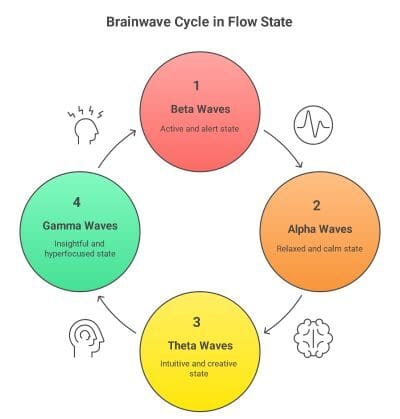There are times when everything just clicks. You lose track of time, you stop overthinking and you move, speak, or work almost without effort. That is where you achieve better focus and flow. You may experience flow state for a few minutes or a few hours at a time.
Breathing plays a direct role in this process. Fast or shallow breathing sends a signal of tension to the brain, while light, quiet breathing supports calm and alert focus. Each breath influences heart rhythm, blood chemistry, and the brain’s electrical activity.
When the mind is steady, attention becomes easier to hold. Functional breathing creates the conditions that allow the brain to stay engaged longer and reach the level of focus known as flow.

The Science Behind Flow
Flow is both mental and physical. It depends on coordination between the brain, nervous system, and breathing.
The brain moves through electrical cycles called brainwaves. Beta waves appear during active thought or problem-solving. Alpha and theta waves rise during calm focus, creativity, and skilled movement. During flow, alpha and theta activity increase, while beta activity decreases, allowing focused attention.
The autonomic nervous system changes as well. The sympathetic branch drives alertness, while the parasympathetic branch lowers stress. Slow nasal breathing helps regulate both by keeping heart rate and blood flow steady.
Research shows that breathing around six times per minute increases heart rate variability, an indication of flexibility between effort and recovery. The same breathing rhythm influences the locus coeruleus, a part of the brain linked to attention [1].
These small changes prepare the body and brain for longer periods of focus. When breathing stays calm and efficient, oxygen delivery and mental stability improve—making flow possible.
Breath Patterns and Brainwaves
Breathing rhythm directly affects how the brain works. Changes in the rate or depth of breath changes electrical activity and blood circulation.
Fast, shallow breathing causes more beta wave activity. This usually happens during stress. Slow, nasal breathing leads to alpha and theta waves, which allows for focused attention and better coordination between different brain regions.
When breathing slows, oxygen uptake to the tissues improves and blood circulation becomes more stable. These changes help the brain process information with less effort and keep attention for longer periods.
EEG studies show that steady nasal breathing increases activity in areas that are responsible for attention and memory [2][3]]. This creates the physiological conditions needed for focus and flow.

Functional Breathing and Mental Clarity
When breathing is heavy or fast, too much carbon dioxide (CO₂) is lost. This reduces oxygen release from the blood and limits delivery to the brain, often causing tiredness and lack of concentration.
Functional breathing keeps oxygen and carbon dioxide in balance with:
- Light breathing: only as much air as the body needs.
- Nasal breathing: slows, filters and conditions air for the lungs.
- Quiet exhalation: helps preserve CO₂ and maintain breathing pressure.
This approach to breathing improves blood flow to the brain supporting activity in the prefrontal cortex, which manages focus and decision-making. Consistent, light breathing helps keep thinking clearer and more focused for a longer period without greater effort or concentration.
Slow Breathing and Theta States
Breathing about six times per minute increases theta wave activity in the brain. These waves are related to forming memories, creativity, and longer attention.
Breathing at this rate also:
- Improves heart rate variability (HRV), showing better coordination between heart rhythm and breathing.
- Increases blood flow to the brain, improving oxygen delivery and nutrient exchange.
- Supports the autonomic nervous system by reducing stress and helping the body recover more quickly between activities.
This rhythm appears naturally in meditation, slow endurance training, and steady-paced work. Slow, light breathing keeps oxygenation and blood pressure steady, allowing the brain to stay alert and focused for longer periods.
When Over breathing Blocks Flow
Over breathing happens when you breathe faster or deeper than needed for the body’s current needs. It decreases the level of carbon dioxide (CO₂) in the blood, which disrupts oxygen delivery to tissues, including the brain, due to the Bohr effect.
Low CO₂ causes blood vessels in the brain to narrow which reduces blood flow and the availability of oxygen. This can cause:
- A feeling of mental fog or slower thinking
- Headache or lightheadedness
- Tension in the neck and shoulders
- Shorter attention span
These effects are common during stress or heavy mouth breathing. The body interprets this pattern as a mild stress signal, even when no threat is present.
Bringing back nasal breathing reverses the process. Breathing lightly and allowing CO₂ to return to normal levels dilates blood vessels and improves oxygen flow. Mental clarity and focus usually improve within minutes.

Using Breath as a Mental Tool
Breathing can be used as a method to improve focus and gain emotional control. The rate (breaths per minute), depth (from the diaphragm or from the chest), and route (nose or mouth breathing) of each breath influence how alert or calm the brain becomes.
Key tools include:
- Slow nasal breathing lowers heart rate and steadies attention.
- Brief breath holds after exhaling increase alertness and relaxation and can help decongest the nose.
- Longer exhales activate the parasympathetic system to decrease stress.
The effect of these tools result in changes in blood gases and sends signals to and from the lungs and diaphragm to the brainstem. With regular practice, controlled breathing reduces stress and provides for better mental performance.
Better Focus and Flow Starts with the Breath
Flow depends on how well the body supports the brain. Steady breathing, consistent circulation, and balanced oxygen and carbon dioxide levels create the conditions that allow focus to last.
Light, quiet, nasal breathing maintains this balance by keeping CO₂ within an appropriate range and keeping heart rhythm stable – synched to breathing.
Practicing controlled breathing before or during focused work helps maintain focus for consistent performance. Flow can happen when the body remains calm and is well-regulated.
Check out The Psychology of Anchoring Calm: How to Best Handle Stress.







